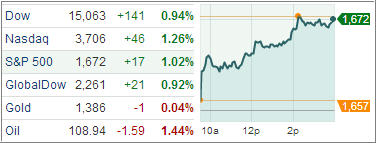Global economic optimism, courtesy of a stronger-than-expected read on Chinese August exports and a sharp upward revision to Japan’s 2Q GDP growth, helped to propel stocks to start the week. U.S. markets closed sharply higher on Monday, with the Nasdaq ending at its highest level since September 2000.
Sentiment was also lifted by merger activity and easing concerns about a potential Western-led strike on Syria. Meanwhile, consumer credit was the only item on today’s economic calendar, showing that consumer credit expanded at a smaller-than-expected pace.
U.S. equities climbed from the open thanks to China reported overnight a larger-than-expected trade surplus as imports grew 7.0% (11.3% expected) and exports increased 7.2% (6.0% forecast). Elsewhere, Japan saw its second quarter GDP revised up to 0.9% quarter-over-quarter from 0.6% and Tokyo received the nod to host the 2020 Olympics.
Growth-sensitive sectors paced the advance with materials ending in the lead. The sector rose 1.5% as steelmakers rallied in reaction to the data from Asia. The Market Vectors Steel ETF jumped 2.8%. Other commodity-related sectors also displayed strength. Industrials (+1.2%) were bolstered by broad gains among transportation companies and machinery producers. The Dow Jones Transportation Average rose 1.4% and Dow component Caterpillar, which does a significant amount of business in China, advanced 2.6%.
The energy sector (+1.0%) also outperformed even as crude oil fell 1.4% to $109.04 per barrel. Crude futures slid to their lows after reports indicating some cautious optimism hoping that a diplomatic solution remains within the realm of possibilities for Syria.
With regard to other cyclical sectors, technology (+1.3%) displayed strength throughout the day. The largest sector component, Apple, gained 1.6% ahead of tomorrow’s product refresh. Elsewhere, discretionary shares finished in-line with the S&P, which overshadowed the broad gains among homebuilders. The iShares Dow Jones US Home Construction ETF spiked 4.3%. Countercyclical sectors lagged across the board as consumer staples, health care, telecom services, and utilities added between 0.2% and 0.8%. Can we expect the market to continue its upward trend?
Economists forecast the central bank will reduce its monthly $85 billion in asset buying by $10 billion at its meeting on Sept. 17-18. However, last week payrolls report showed increase less than projected in August and gains in the prior two months were revised downward, fueling speculation that any Fed move to taper its stimulus program will be limited.
Our Trend Tracking Indexes (TTIs) picked up speed as well and closed above their respective long-term trend lines as follows:
Domestic TTI: +1.86%
International TTI: +5.26%
Contact Ulli
